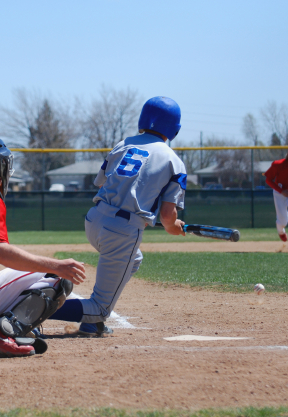The Situation:
There’s a runner on 1st and no outs in the top of the 4th inning. It’s a 1-1 game and the 8-hole hitter is up. He has slightly above average speed and it’s a definite bunt situation given the team’s offensive tendencies. The defense is willing to get the out on the sacrifice. The right-handed pitcher toes the rubber ready to deliver a fastball over the plate.
The Play:
The expected bunt comes and the batter chops the ball into the ground about a foot in front of home plate. The angle of the bunt is back towards the mound, but the first hop off the dirt is high as the ball chops towards the mound. The only play will be to first and the catcher points and alerts his pitcher with a loud “One” call. As the pitcher approaches the ball, he is caught between going to get the second hop on the short-hop and waiting for the ball to bounce a second time. He pulls up and waits to get the long second hop, which ends up being more of an in-between hop. He catches it on its way up, wrestling with the transfer and getting his throw off at an unhurried pace.
The Outcome:
The pitcher gets off of strong throw to first, but the batters foot gets in just in time. It’s a bang-bang play and the umpire gets it right. The runner is safe with a bunt single and there are no outs and runners on first and second. The pitcher is a little bit confused as to how the runner beat out a bunt right back to him, but he’s now in hot water.
What Went Wrong:
This is a mistake we see play out often and the reason is usually lack of pattern recognition or poor intensity/creativity during PFP’s (Pitcher Fielding Practice). Let’s explore this more in-depth.
We can break fielding the bunt down into 3 components. The time it takes for the fielder to get to the ball (We’ll call Part A)+ the time it takes the fielder to get the throw off (Part B) + the time it takes from fielder release to the first baseman’s glove (Part C). Anytime one part of the equation gets longer, the time must be made up in the other two parts. When a bunt is chopped into the ground, it takes longer for a defender to close on it because the ball is not gaining distance towards the fielder as quickly as it would if it was rolling. In essence, the height of the chop is buying the runner time to get down the line and can easily make up for the poor angle of a bunt. Pitchers and corner fielders need to be acutely aware of the fact that Part A of the fielding equation will take longer if they play it at normal speed and either speed up Part B and/or Part C or attack the ball to cut down on the time in Part A. It should be noted that it is incredibly hard to make up a lot of time during the throw (Part C). The difference between throwing the ball to first 70 miles per hour verses 80 miles per hour simply isn’t that much.
What often happens on this type of play, however, is pitchers play it at normal speed because they are accustomed to easy bunts being rolled to them during PFP, and have not trained to recognized the pattern of the chopped bunt. If the pitcher’s internal clock is calibrated well, the correct play is to go get the second hop as a short-hop, almost like an infielder playing through a chopped ground ball. By waiting for a more comfortable or common second hop, the pitcher simply wastes valuable time that he doesn’t try to make up. It’s nothing more than a poor internal clock.
As a coach, you can train for this by having pitchers field the range of bunts they will deal with in the game during PFP’s, work on fielding the ball like an infielder (fielding short-hops, picking out hops, attacking the ball under control, etc.), and developing the internal clock or game clock by using a stopwatch to let them know if their throws are getting to first base on time. Going through the motions during PFP’s is where the mistake in this play is born. Preparation matters a great deal. As a pitcher, PFP time is your defensive life blood. Take it seriously, practice at game speed, prepare for the full range of plays you will be asked to defend, recognize patterns and always think the game!







